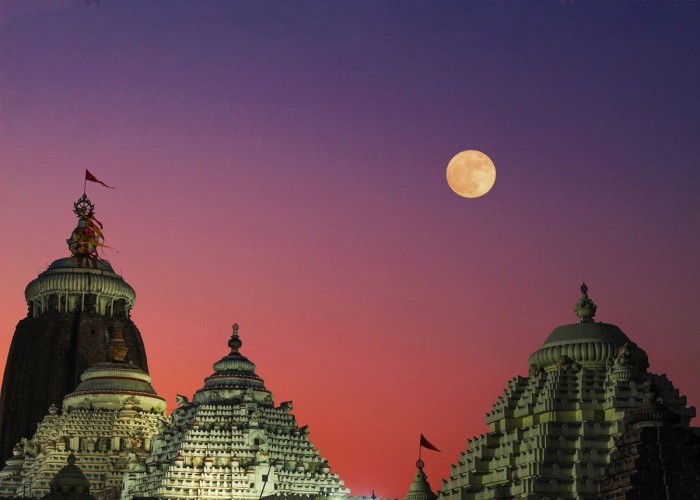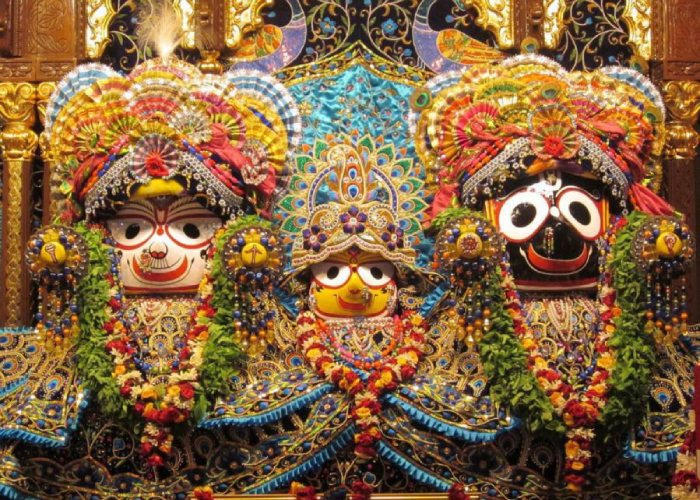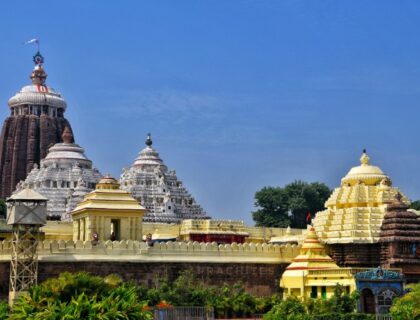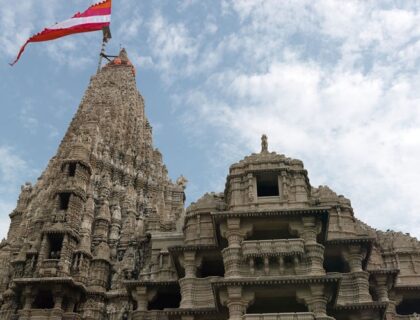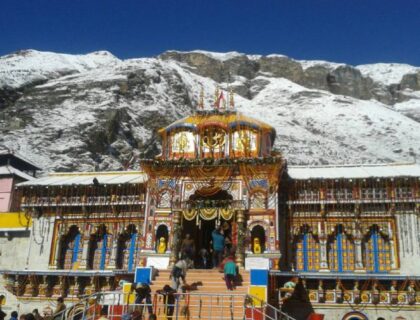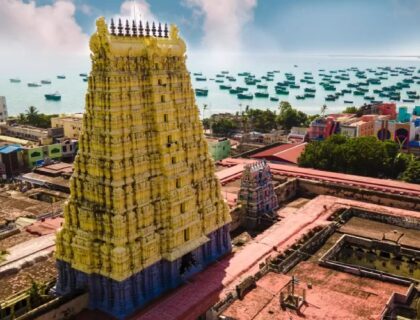Jagannath Temple Puri
The Jagannath Temple is a significant Hindu temple dedicated to Jagannath, a form of Vishnu located In Puri on India’s eastern coast in the state of Odisha. Jagannath is also known as one of Hinduism’s three supreme divinities. This temple was last constructed by Avanti’s King Indradyumna in Puri. This temple is also considered Char Dham Temple.
Lord Jagannatha, as His name implies, is the Lord of the Universe (Jogat = Universe; Lord = Natha). He is also known as Mahaprabhu, which means “great;” Lord is Prabhu. In the sacred scriptures of Sanatana Vaidika Dharma, also known as Hinduism, he is referred to as Purushottama, the Supreme Divine Being. (Purusha means Divine Being; Uttama means Supreme Being). Numerous scriptures, including the Vedas, the earliest human scriptures, the Puranas, and later literary works written in Sanskrit and Odia, recount Lord Jagannatha’s glory.
Lord Jagannatha is referred to as the One Omnipotent, Omnipresent, and Omniscient Supreme God in the Sanatana Vaidika Dharma scriptures. He is also referred to as Paramatma (Supreme Self), Parameshwara (Supreme Lord), and Param-Brahman (Supreme Omnipresent God). These names and forms are invoked in a wide variety of religious traditions and beliefs all over the world.
Story Behind Jagannath Temple Puri
The traditional story goes that at the end of the Dvapara yuga, the original image of Jagannath (a deity form of Vishnu) appeared here in the form of an Indranila mani (also known as the Blue Jewel) near a banyan tree and near the sea. It was so amazing that it could provide instant moksha that the God Dharma or Yama had to hide it in the earth and it was fruitful.
In order to find that mysterious image, King Indradyumna of Malwa in Kali Yuga performed severe penance. Lord Vishnu then instructed him to go to the Puri beach and find a floating log in order to create an image from its trunk.
The King discovered the wood log. He performed a yajna, and God Nrisimha emerged from it. He instructed Paramatma to create a fourfold expansion of Narayana, with Paramatma as Vasudeva, his Vyuha as Samkarshana, Yogamaya as Subhadra, and Vibhava as Sudarsana. Vishwakarma, dressed as an artisan, carved images of Jagannath, Balabhadra, and Subhadra from the tree.

When Narada saw this glowing log floating in the sea, he instructed the king to sculpt three deities from it and set them up in a pavilion. Indradyumna persuaded Visvakarma, the god-architect, to construct a magnificent temple for the deities. Vishnu, disguised as a carpenter, then appeared to create the deities on the condition that he be left alone until he completed his work.
However, after only two weeks, the Queen became extremely concerned. She assumed the carpenter was dead because she had not heard any voice from the temple. As a result, she begged the king to open the door. As a result, they went to see Vishnu at work, but he left without finishing the deities. The deity had no hands on him. A divine voice, however, instructed Indradyumana to place them in the temple. It is also widely held that the deity can rule the world despite not having hands. As a result, the idiom was placed inside the temple.
History of Jagannath Temple Puri
According to his descendant Narasimhadeva II’s Kendupatna copper-plate inscription, Ganga dynasty king Anantavarman Chodaganga rebuilt the Jagannath Temple in the 10th century CE. Anantavarman was a Shaivite at first but converted to Vaishnavism after conquering the Utkala region, where the temple is located, in 1112 CE. An inscription from 1134-1135 CE records his donation to the temple. Therefore, the temple’s construction must have begun after 1112 CE.
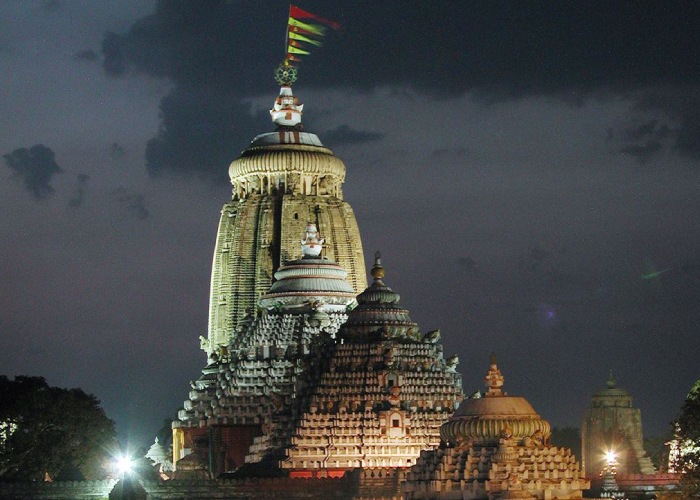
Drawing from the book L’Inde des rajahs: A Voyage through Central India, including Bombay and Bengale, 187, According to a legend in the temple chronicles, Anangabhima-deva II established it. This indicates that the temple was completed or renovated during the reign of Anantavarman’s son Anangabhima. The temple complex was expanded during the reigns of subsequent kings, including those of the Ganga and Gajapati dynasties. The year of construction is mentioned in various ways in different chronicles.
Architecture of Jagannath Temple Puri
The massive temple complex, which measures over 400,000 square feet (37,000 m2), is surrounded by a high fortified wall. This 20 feet (6.1 m) high wall is known as Meghanada Pacheri. A second wall known as kurma bedha surrounds the main temple. There are at least 120 shrines and temples in the area. It is one of India’s most magnificent monuments due to the fluidity and sculptural richness of the Oriya style of temple architecture.
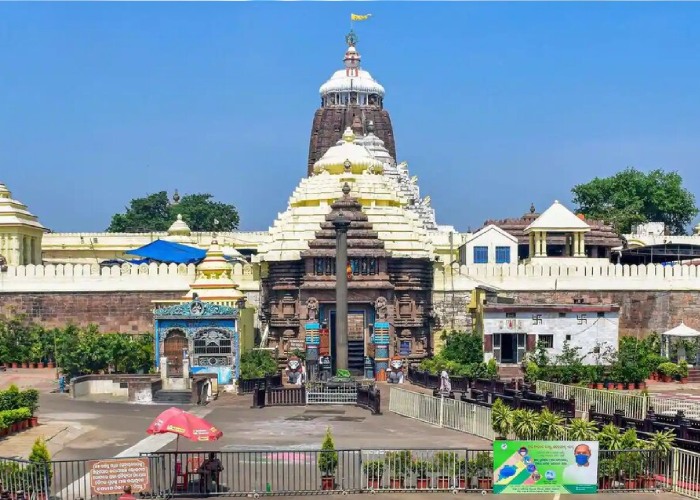
There are four distinct sectional structures in the temple:
- Deula, Vimana or Garba griha (Sanctum sanctorum) where the set of three gods are stopped on the Ratna Vedi (Lofty position of Pearls). Styled after Rekha Deula;
- The front porch, or mukhashala.
- Nata mandir/Natamandapa, which is also known as the Jagamohan (Audience Hall/Dancing Hall)
- Bhoga Mandapa (Offerings Hall).
Facts about Jagannath Temple Puri
- Shree Jagannath Temple in Puri, viewed as one of the four dhams (journeys) of India, is situated in the old city of Puri, in the territory of Odisha.
- This Jagannath Temple is dedicated to Lord Jagannath, the Lord of the Universe in the form of Lord Krishna (The Incarnation of Lord Vishnu) receives millions of devotees annually. During the well-known Rath Yatra festival, this number rises exponentially.
- In addition to the main temple, which has many interesting stories associated with it, this shrine, built in the Kalinga style, has several smaller temples in the complex.
- The Jagannath Temple Puri’s ancient gates and stunning architecture offer a glimpse into the past’s masterful craftsmanship.
- Because of its construction, the main Jagannath Temple never casts a shadow on the ground during the day.
- The Nilachakra – Or the Blue wheel perched on top of the temple is made of eight metals or asta dhatu. It is believed that if you see the Nilachakra it is as good as seeing the Lord himself.
- The flag or the Patitapabana flows in the opposite direction of the wind and is changed every day at sunset. A royally appointed family is in charge of changing the flag. They climb 165 meters in bare feet with no support in this ritual, this ritual has been going on for over 800 years.
- The offering to the Lord known as the Mahaprasad is cooked over a fire that is stoked by rice, vegetables, cereals, and other items. are placed one on top of the other on the fire in earthen pots. The cooking begins in the pot on top.
- Another distinguishing feature of the temple is that the holy trinity’s idols are made of wood rather than stone or metal. They are also the only deity who demonstrates mortality.
Famous Festivals In Jagannath Temple Puri
Devasnana Purnima is the annual bathing ceremony in which the holy trinity emerges from their sanctum on a raised platform and bathes in pure water that comes from a well on the grounds of the temple.
Chariot Celebration – This happens in the months of June and July. During the celebration, God appears on the road to greet his lovers, and anyone, regardless of station, belief, or variety, can seek his favours.
How To reach Jagannath Temple Puri
Puri is well-connected to several places like Kolkata, Delhi, and Bhubaneswar. There are direct train facilities available to reach Jagannath Temp in Puri.
By Air: Nearest Airport is Biju Patnaik International Air Port at Bhubaneswar 60 Km
By Rail: The Nearest Railway Station is Puri which is 3 Km from Jagannath Temple.
By Road: Regular Bus, Taxi and Auto Services are available from Bhubaneswar and Railway Station at Puri
Location
Facilities
- Drinking Water
- Pooja Item Shops
- Prasad Shops
- Restaurants Nearby
- Resting Room





